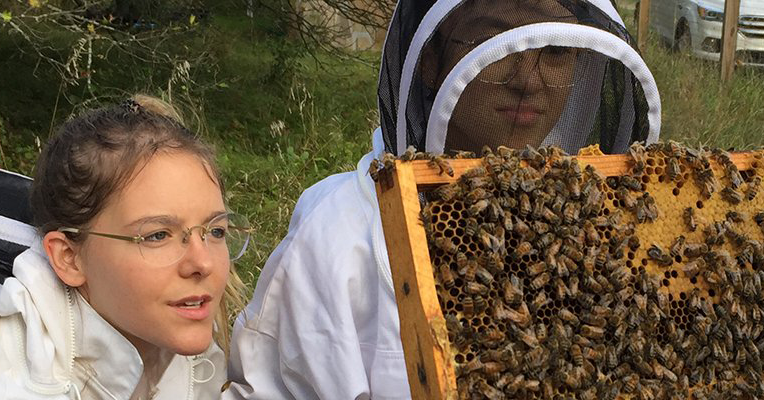On a September afternoon, I watched as a group with UMBees, a student organization, tended to the hives of roughly 100,000 bees. Dressed in protective clothing, we were standing in front of two tall columns of stackable wooden boxes located deep in U-M’s Matthaei Botanical Gardens. For my benefit, they were trying to find the queen of the colony.
“She can’t be far away. The egg is upright,” said Andrew Mills, the faculty adviser for UMBees, explaining that queen bees can lay up to 1,500 eggs per day (each shaped like a grain of rice). “Day one, they’re upright; day two, they start to lean over; day three, they lie flat on the bottom of the cell. After three full days, they hatch.”
With us was U-M senior Gucci Fan, the head of the club who is loftily referred to as the “minister of the apiary,” and three alumni from UMBees. Founded in 2012, the organization’s mission is to “promote, protect, and partner with the species Apis mellifera.”
We initially approached the hives from the rear, so as not to interfere with the flight paths of the bees entering and exiting the boxes. Fan lit the smoker, a hand-held device filled with paper and twigs. Then, with a few pumps of the bellows, she wafted puffs of smoke around one of the hives to stop the bees’ alarm pheromones so the colony would not react as aggressively to our intrusion.
Hopping up on a bench, Fan lifted the cover from the hive, and the buzzing sound increased a few decibels. Next, Mills installed glass jars filled with sugar water and vitamins into the hive. “We feed the colony in the fall to make sure the bees are nice and fat to help them survive the winter,” said Mills, who I met through Ann Arbor Backyard Beekeepers, a local club.
Using a medieval-looking tool, Fan pried the sticky corner of one 19-by-9-inch frame up and lifted it out of the hive, and then another, passing them among Amol Shah, ’19, Anshul Kumar Kulkarni, ’19, and Taylor Landeryou, ’16, MS’18.
The members of UMBees started to buzz … with excitement.
“Oh look—eggs!” said Shah.
“The honey is just dripping!” said Landeryou, a student program coordinator at the Ross School of Business, as she fearlessly removed her headgear. “My dream,” she said, “is to get bees into the B school.”
More Buzz on Bees
Did you know?
- A honeybee visits 50 to 100 flowers during a pollen collection trip.
- Most amateur beekeepers lose anywhere from 30 to 50% of their bees each winter. UMBees has not lost a colony in two years.
- A honeybee can fly for 6 miles and as fast as 15 mph.
- Honeybees never sleep.
- There are over 4,000 species of bees in the world.
- The bees’ buzz comes from their wings, which beat 11,400 times per minute.
- Honeybees are not native to North America. They arrived on boats from Europe in the 1600s.
- Honeybees have produced honey in the same way for 150 million years.
- Honeybees communicate through dancing and pheromones.
As I now know, when one is close to a vibrant, healthy bee colony, it is easy to forget that the Apis mellifera species is in jeopardy. Honeybees pollinate crops like apples, melons, and broccoli. Blueberries and cherries are 90% dependent and almonds are entirely dependent on the honeybee for pollination. Threats to the species—like climate change, habitat loss, and pesticides—are big. But efforts from small, grassroots organizations can make a difference to the species’ survival.
Every bee in a colony has a specific responsibility. The majority are worker bees, non-reproducing females, who tend to the brood, keep the hive clean, and collect pollen and nectar. The male drones’ primary job is to mate with the queen.
But where was the queen?
A search began. With each box housing 10 frames, this was no simple show and tell.
“There’s the queen!” Fan exclaimed. We watched as a retinue of worker bees tended to her long body, moving gracefully across the frame.
I felt honored to have had this intimate look at a fascinating species that is majestic and vital to our world.
Chris Hippler is a freelance writer who retired from the advertising/marketing business in 2018. He is busy launching his new business, Worker Bee Jewelry, casting natural found objects in silver and gold.





